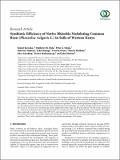| dc.contributor.author | Fanuel Kawaka, Mathews M Dida, Peter A Opala, Omwoyo Ombori, John Maingi, Newton Osoro, Morris Muthini, Alice Amoding, Dative Mukaminega, John Muoma | |
| dc.date.accessioned | 2020-08-12T07:09:49Z | |
| dc.date.available | 2020-08-12T07:09:49Z | |
| dc.date.issued | 2014 | |
| dc.identifier.uri | https://repository.maseno.ac.ke/handle/123456789/1994 | |
| dc.description.abstract | This study was conducted to determine the abundance and symbiotic efficiency of native rhizobia nodulating common bean in Kisumu and Kakamega, Kenya. Soil sampling was carried out in three farms that had been used for growing common bean for at least two seasons and one fallow land with no known history of growing common bean or inoculation. Abundance of soil rhizobia and symbiotic efficiency (SE) were determined in a greenhouse experiment. Native rhizobia populations ranged from to cells per gram of soil. Pure bacterial cultures isolated from fresh and healthy root nodules exhibited typical characteristics of Rhizobium sp. on yeast extract mannitol agar media supplemented with Congo red. Bean inoculation with the isolates significantly increased the shoot dry weight and nitrogen (N) concentration and content. The SE of all the native rhizobia were higher when compared to a reference strain, CIAT 899 (67%), and ranged from 74% to 170%. Four isolates had SE above a second reference strain, Strain 446 (110%). Our results demonstrate the presence of native rhizobia that are potentially superior to the commercial inoculants. These can be exploited to enhance bean inoculation programmes in the region. | en_US |
| dc.publisher | Hindawi | en_US |
| dc.subject | Soil sampling, bean. | en_US |
| dc.title | Symbiotic efficiency of native rhizobia nodulating common bean (Phaseolus vulgaris L.) in soils of Western Kenya | en_US |
| dc.type | Article | en_US |

